SIMPLE FINANCE
Jan 2018-May 2018
SIMPLE FINANCE
Jan 2018-May 2018
SIMPLE FINANCE
Jan 2018-May 2018
SIMPLE FINANCE
Jan 2018-May 2018
SIMPLE FINANCE
Jan 2018-May 2018
Just For Today App
PROJECT TYPE
Capstone / Passion Project
TIMELINE
May 2018 - Dec 2019

OVERVIEW
Defining Problems

01
The current transition process from treatment to the real world is precarious and lacks structure and consistency.

04
No consistent way to shift a pro- drinking and drugging social network to a pro-abstinence social network.

02
Parole officers are punitive and current methods for sending addicts to 12-Step program are ineffective.

05
No means for those in early and long term recovery to visualize actual progress and consistency.

03
No means for an alcoholic's support system to know if they are participating in the activities that keep them sober or to see early signs of relapse.
OVERVIEW
Design & Strategy Process

PRIMARY RESEARH
In-depth Interviews
4 Female Recovering Alcoholics
7 Male Recovering Alcoholics
Therapist Specialized in Addiction
Intervention Specialist
2 Parole Officers
Defense Attorney
Exec of a Treatment Center
PRIMARY RESEARH
Mapping Key Players

The key relationship in recovery is between the alcoholics and their sponsor. Sponsors are A.A. members who have worked the 12 steps of A.A. as a way to attain sobriety and are often in the best position to share their experience, understanding of the A.A. program, and outline the 12 steps.
PRIMARY RESEARH
Personas
Personas were developed based off of a speaking format used in meetings. Individuals are asked to present their recovery journey first by how it was before recovery, then what happened to get sober, and how is it now.
SECONDARY RESEARCH
Behavior Based Research
One of the biggest elements in the research included understanding the psychology of addiction in terms of how people become addicts, how they become clean and sober, and then how they manage staying in recovery. To understand the process of how individuals create habits, you must understand operant conditioning.
Operant conditioning is a behaviorist theory based on the idea that behaviors that are reinforced will continue while behaviors that are punished will eventually end. Through operant conditioning, an individual makes an association between a particular behavior and a consequence. This theory was developed by behaviorist and psychologist BF Skinner.
Behavior which is immediately followed and reinforced by positive consequences is more likely to be repeated, and behavior followed by negative consequences is less likely to be repeated. Positive reinforcement immediately following a desirable behavior is the most powerful and long lasting of the four types and a key factor in shifting undesirable behaviors into desirable and sustainable new behaviors. In the field of behavioral psychology, if a behavior can be repeatedly, constantly, and precisely reinforced over time, the likelihood that the behavior will be repeated crescendos. Basically, every discipline, no matter how small, is an opportunity to apply positive reinforcement to a recovering alcoholic for taking steps in choosing to be sober.

Operant conditioning is a learning process through which the strength of a behavior is modified by reinforcement or punishment. Positive reinforcement for correct behavior is the most powerful and long lasting for behavior change.
SECONDARY RESEARCH
Understanding The Skinner Approach
Skinner stipulated two instances of adding a stimulus:
-
Reinforcement for correct behavior (ex: getting a message of support from your sponsor for attending an A.A. meeting)
-
Reinforcement for correct behavior (ex: getting a message of support from your sponsor for attending an A.A. meeting)
Although not necessarily intuitive, both are adding a stimulus to increase a behavior; and therefore, both are instances of positive reinforcement. Skinner advised that positive reinforcement for incorrect behavior only increases that behavior to meet minimum requirements, and as a result, is difficult to sustain in the long run.
Skinner also proved that repeated positive reinforcement for correct behavior engages discretionary behavior where the participant chooses to repeat the behavior because they want to, and not because they feel they have to repeat it. This is a key feature of operant conditioning – focusing on giving credit for what is done correctly.
2.

Positive reinforcement that focuses on enforcing mostly correct behavior allows users to surpass previous performance and change the mind set from 'have-to' to 'want-to.'
RESEARCH OUTCOMES
Opportunity Analysis

01
Immediate Recognition
Human and system reinforcement is applied immediately after completing as discipline then enabling successful operant conditioning

04
Progress Feedback
Gives users an overview and history of their progress letting them know where in their program they are succeeding and where they can make improvement

02
Ease of Transition
Brings more consistency to the transition out of treatment and back into everyday life

05
Convenient Program Management
Human and system reinforcement is applied immediately after completing as discipline enabling successful operant conditioning

03
Micro Social Support
Shifts pro drinking and drugging network to pro abstinence network.

06
Engaging Discretionary Behavior
Repeated reinforcement for correct behavior engages discretionary behavior where the user choses to repeat the behavior because they want to, not because they feel they have to.
PRODUCT DEVELOPMENT

Experience Mapping
PRODUCT DEVELOPMENT
Main Screen Anatomy

PRODUCT FEATURES
Discipline Management
The app provides a calendarized, customizable menu of the 12-Step daily disciplines which the alcoholic generally completes on a daily basis. A menu of the daily discipline options allows them to add and edit to build their day.
The successful completion of most of the daily disciplines can be sensed by the app and the smartphone’s sensor and data technology. For example, the technology can sense that the user called his sponsor on the correct time each day because his sponsor’s phone number link was activated in the app.


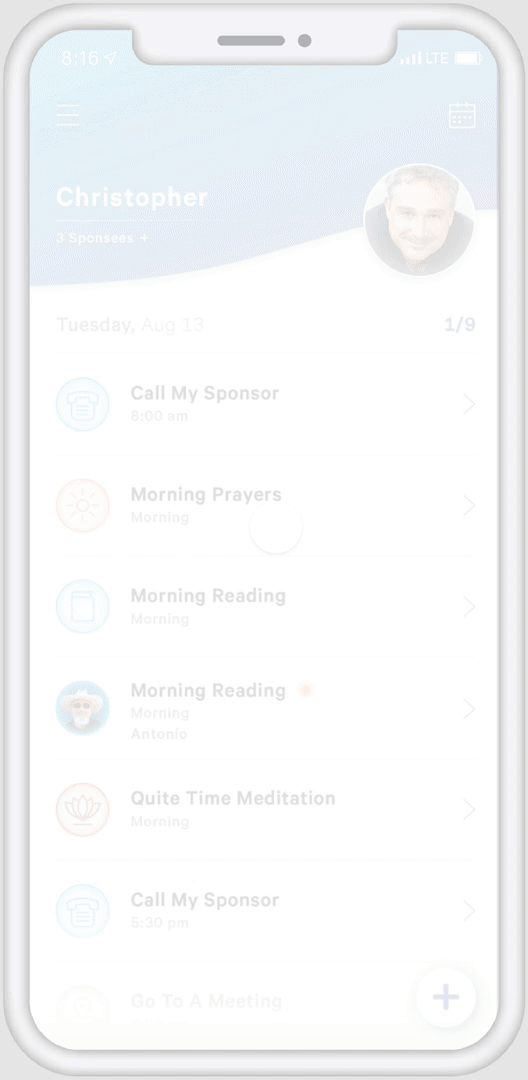

PRODUCT FEATURES
This key feature of the app enables a micro social network with intention and capability to be supportive in a way that goes beyond what currently exists. It transitions the app from being punitive to supportive and dispels Big Brother concerns by catching users in the act of being primarily correct rather than incorrect.
Human and System-Driven Reinforcement
Human Reinforcement:
Support system members will be prompted to share positive reinforcement in the form of text, voice message, or even a phone call immediately following the completion of one of the daily disciplines. Over time, as the user becomes consistent in completing the daily disciplines, the app asks the support system to reinforce less frequently.
System Reinforcemen
The Just For Today app knows if the daily disciplines have been completed or not completed on time, which allows the app to provide the behavior reinforcement messaging in real-time. System-based behavior reinforcement has the advantage of providing impeccable reinforcement timing at the moment of completion which is a key aspect of the mechanism of operant conditioning.
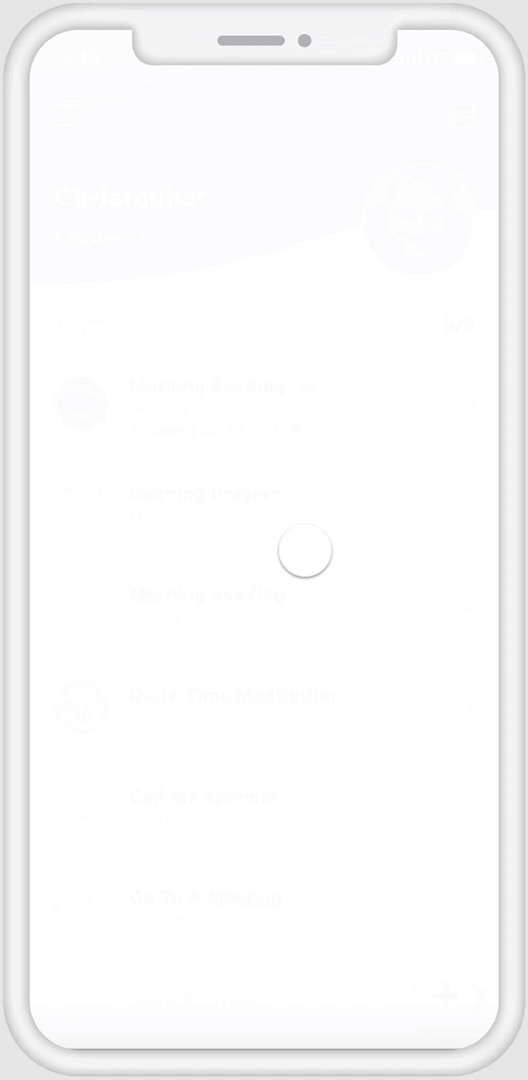


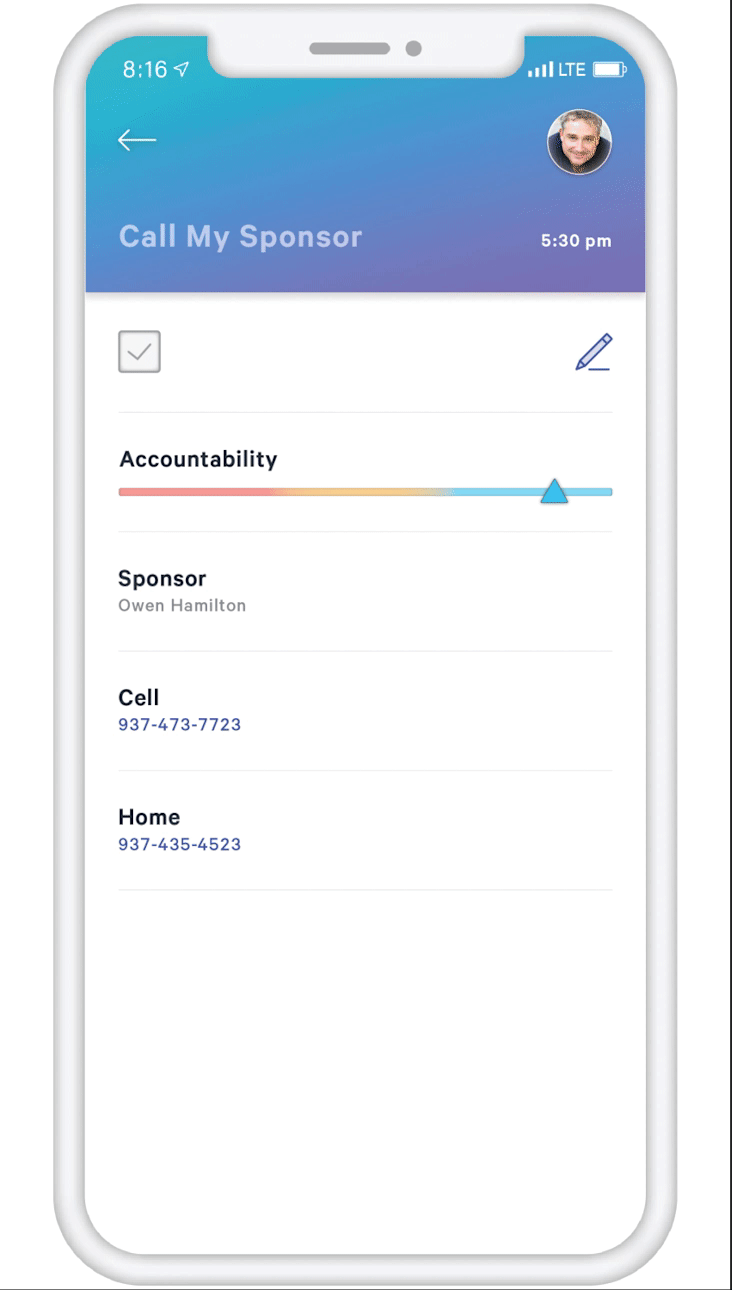
PRODUCT FEATURES
Progress & Accountability
Within each discipline is a color coded accountability meter to help users visualize progress. Disciplines that are in the red zone need more work while those that are in the green zone are being completed with perfection. This color score is also present next to each calendarized discipline within the home screen to give users a quick overview of the disciplines in their day that need more attention.
The app offers an analytics section for more detailed information. The analytics page provides a history preview for each discipline to show improvement or decline over time.
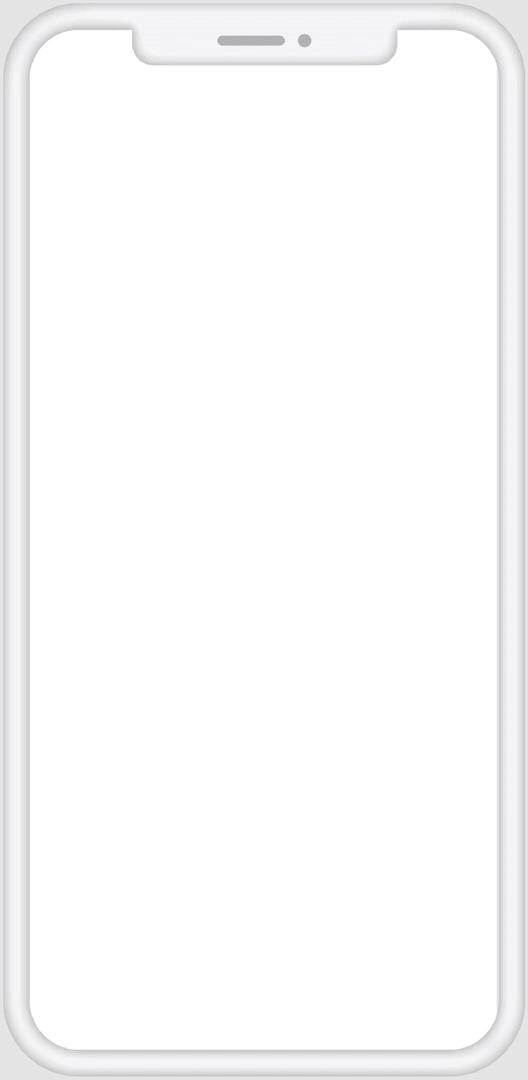

PRODUCT FEATURES
Support Management
Those who are new to A.A. and using the app may struggle with building a schedule of disciplines that is right for them. To solve this problem, users can give specific individuals in their support system the ability to add and edit tasks. Overtime if the user feels confident with being accountable in building and completing his own schedule, he can edit the control of his support member to the viewership that he desires.
The user can decide if he wants individuals in his support system to view and edit disciplines, just view progress, or have no viewership and just be a contact within his system. For sponsors who are working their own program, Just For Today easily integrates viewership of their sponsees within the same app.
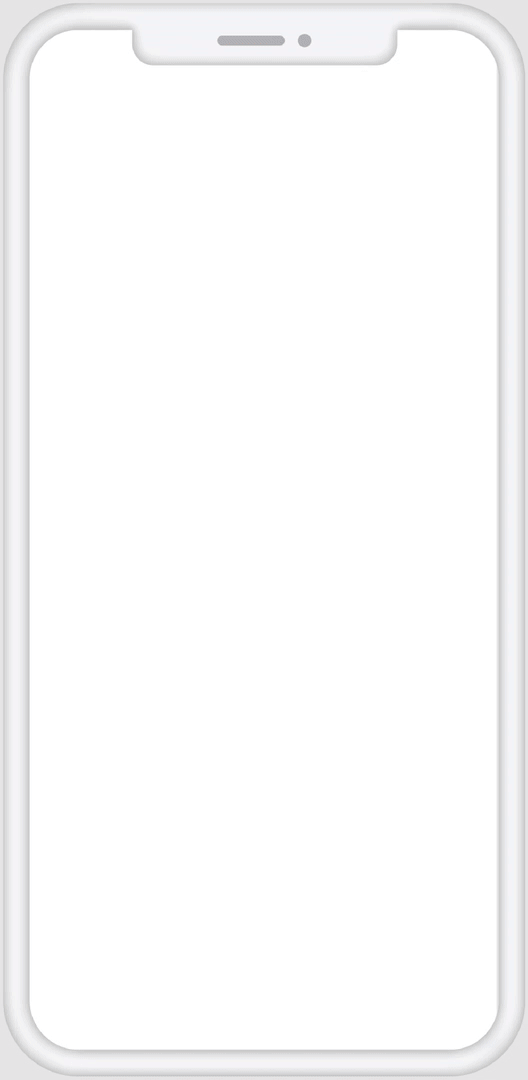
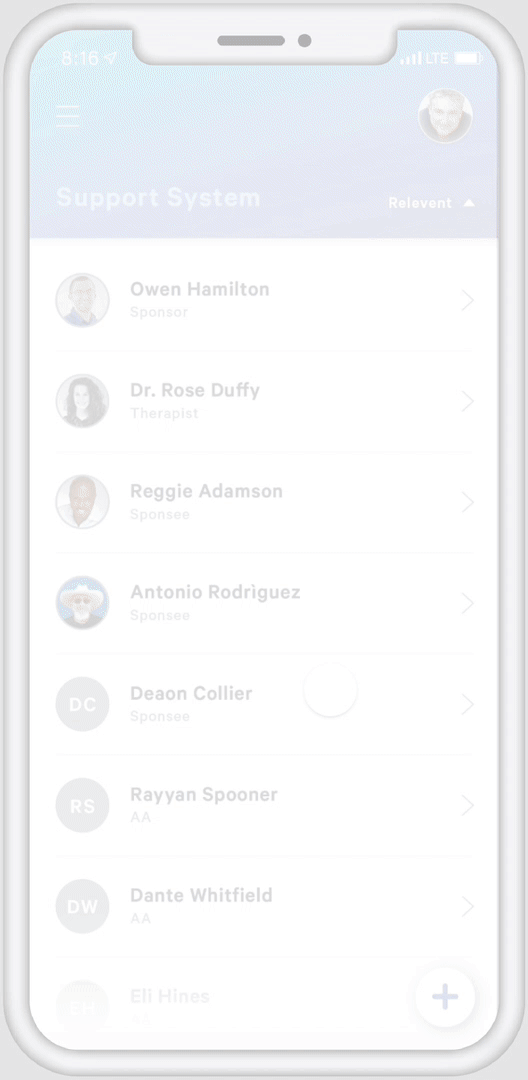



PRODUCT FEATURES
UI Designs






Key Learnings and Reflection
This project really helped me to refine my visual and organizational skills as an interaction designer and to fully think through the development and functionality of a product. Rather than designing features for an already existing product, I challenged myself to build a concept completely from scratch. This challenge required me to think more critically about how each component, interaction, and design affected the primary problems I set out to solve.
In this experience I also learned how to successfully apply empathy to outline problems and then allow those problems to be the driving factors in my design decisions. The ability to define my solution relied not only on gathering objective research data about addiction, but also on putting myself in my users' shoes on a human experience level. Overall, I feel proud to have designed a tool that could really help people who are looking for guidance and support in recovery and, in the process, to have also learned to have more compassion for people dealing with addiction.
